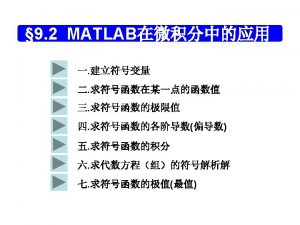RETENTION LIMIT OF THE LANDOWNER RETENTION LIMIT Is









- Slides: 9

RETENTION LIMIT OF THE LANDOWNER

RETENTION LIMIT Is the size of the land an individual owner will be allowed to keep or retain, whether he/she is cultivator or not. Section 6 of R. A. 6657 provides that the retention limit of the landowner whether natural or juridical whose land are covered under CARP is entitled to maximum of 5 hectares of their land. In addition, each child of the landowner may be awarded 3 hectares, provided he/she is at least 15 years old actually tilling the land or directly managing the farm at the time CARL took effect. However, under PD 27, a landowner may retain not more than 7 hectares, if such landowner is cultivating the area or now will cultivate it. While original homestead grantees of their direct compulsory heirs who still own the original homestead may retain 24 hectares as long as they continue to cultivate the homestead.

LAND ACQUISITION AND COMPENSATION FOR PURPOSE OF ACQUISITION OF PRIVATE LAND, THE FOLLOWING PROCEDURES SHALL BE FOLLOWED. 1. After the land, landowner, and beneficiaries shall have been identified, the DAR shall send its notice to acquire the land to the owner thereof, and post the same in a conspicuous place in the municipal building and barangay hall of the place where the property is located. Said notice shall contain the offer of the DAR to pay a corresponding value of the land. 2. Within thirty (30) days from the date receipt of written notice by personal delivery or registered mail, the landowner, his/her administrator, or representative shall inform the DAR of his/her acceptance or rejection of he offer. 3. If the landowner accept the offer of the DAR, the land bank of the Philippines (LBP) shall pay the landowner the purchase price of he land within thirty (30) days after he executes and deliver a deed of transfer in favor of the government and surrender the certificate of title and other muniments of title.

4. In case of rejection or failure to reply, the DAR shall conduct summary administrative proceeding to determine the compensation of the land by requiring the landowner, the LBP, and other interested parties to submit evidence as to the just compensation for the land, within fifteen (15) days from the receipt of the notice. After the expiration of the above period, the matter deemed submitted for decision. The DAR shall decide the case with thirty (30) days after it is submitted for decision. 5. Upon receipt by the landowner of the corresponding payment or in case of rejection or no response from the landowner, upon the deposit with an accessible blank designated by the DAR of the compensation in cash or LBP bonds in accordance with this act, the DAR shall take immediate possession of the land shall request the proper Register of Deeds to issue a Transfer Certificate of Title (TCT) in the name of the Republic of the Philippines. The DAR shall thereafter proceed with the redistribution of the land to the qualified beneficiaries. 6. Any two disagrees with the decision may bring the matter to the court of proper jurisdiction for final determination of just compensation.

As mandated by he law, just compensation shall be determined based on the following factories: 1. The cost of acquisition of the land. 2. The current value of like properties. 3. Its nature, actual use and income. 4. The sworn valuation by the owner. 5. The tax declaration. 6. the assessment made by government assessors 7. The social and economic benefits contributed by the farmers and the farm workers and by government to the property as well as the nonpayment of taxes or loans secured from any government financing institution on the said land.

The compensation shall be paid in one of the following modes at the option of the landowner: 1. Cash payment, under following terms and condition: a) For lands above fifty (50) hectares, insofar as the excess hectarage is concerned-Twenty-five percent (25%) cash, the balance to be paid in government financial instruments negotiable at any time; b) For lands above twenty-four hectares and up to fifty (50) hectares-Thirty percent (30%) cash, the balance to be paid in government financial instruments negotiable at any time; and c) For lands twenty-four (24) hectares and below-Thirty-five percent (35%) cash, the balance to be paid in government financial instruments negotiable at any time. 2. Shares of stock in government-owned or controlled corporations, LBP preferred shares, physical assets, or other qualified investment in accordance with guidelines set by the Presidential Agrarian Reform Council (PARC); 3. Tax credits which can used against any tax liability; and

4. LBP bonds, which shall have the following features: a) market interest rates aligned with 91 -day treasury bill rates. Ten percent (10%) of the face value of the bonds shall mature every years from the date od issuance until the tenth (10 th) year: provided that should the landowner choose to forego the cash portion, whether in full or in part, shall be paid correspondingly in LBP bonds; b) Transferability and negotiability. Such LBP bonds may be used by the landowner, his successorsin-interest or his assign, up to the amount of their face value for any of the following: i. Acquisition of land or the real properties of the government, including assets under the Assets Privatization Program and others assets foreclosed by government financial institution in the same province or region where the lands for which the bonds were paid are situated; ii. Acquisition of shares of stock of government-owned or controlled corporation or shares or stock owned by the government in private corporation;

iii. Substitution for surely or bail bonds for the provisional release of accused persons, or for performance bonds; iv. Security for loans with any government financial institution, provided the proceeds of the loans shall be invested in an economic enterprise, prefably in a small and medium-scale industry, in the same province or region as the land for which the bonds are paid; v. payment for various taxes and fees to the government provided that the use of bonds for these purposes will be limited to a certain percentage of the outstanding balance of financial instrument , provided, further, that the PARC shall determine the percentages mentioned above; vi. Payment for tuition fees of the immediate family of the original bondholder in government universities, colleges, trade schools, and other institutions; vii. Payment for fees of the immediate family of the original bondholders in government hospitals ; and viii. . Such other uses as he PARC may from time to time allow.

THANK YOU!!!!
 Upper specification limit and lower specification limit
Upper specification limit and lower specification limit Limites de control
Limites de control Cara menggambar grafik fungsi limit
Cara menggambar grafik fungsi limit Vẽ hình chiếu vuông góc của vật thể sau
Vẽ hình chiếu vuông góc của vật thể sau Công thức tính độ biến thiên đông lượng
Công thức tính độ biến thiên đông lượng Phép trừ bù
Phép trừ bù Tỉ lệ cơ thể trẻ em
Tỉ lệ cơ thể trẻ em Thế nào là mạng điện lắp đặt kiểu nổi
Thế nào là mạng điện lắp đặt kiểu nổi Lời thề hippocrates
Lời thề hippocrates Vẽ hình chiếu đứng bằng cạnh của vật thể
Vẽ hình chiếu đứng bằng cạnh của vật thể

















